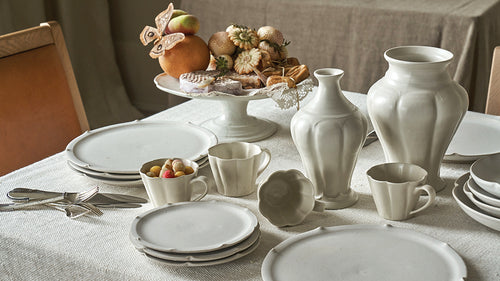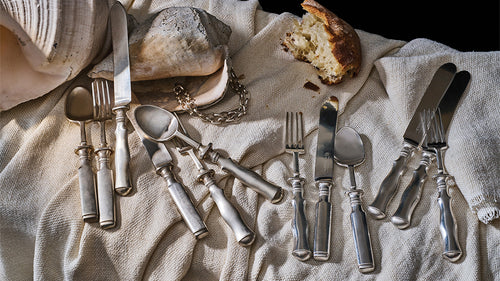THE EYE - - 9:46 AM
Donabes and The New Good Old Ways
The thrill of the "new" so often ages, discolors int he sun, grows brittle, and crumbles into dust. And sometimes old techniques, developed over time, are good for reasons that require time to reveal.
So much human energy is spent trying to escape the dirt and muck, but you can trust earth: there’s a lot more of it than there is us, and it’s not all bad. Our common international history, developing through wires and wavelengths, is new, but our relationship with dirt and the earth isn’t. People have had a long time to study dirt, and invent clever things to do with it. And we’re still learning, or relearning, how to use the soil in new and innovative ways.
Ceramics are both one of the most humble, and highest human crafts. As a category, they are also, in execution, one of the more scientifically complicated arts regularly pursued by solitary individuals, along with cooking.
The donabe, a traditional Japanese clay pot, is a smart piece of hardened, solid rocks and dirt. Made with heat resistant volcanic clay from the Iga Province, the donabe can be used on an open flame, in a fireplace, in an oven, on a stovetop and… technically, perversely, because they lack metal, a microwave as well.
Different compositions of clay are used to form the pot. Igatsuchi is made with fine volcanic soil and is particularly dense – so it must be heated more slowly, but then retains heat for longer. Touhantsuchi is similar, but contains rougher, larger-grained soil that can heat more quickly. This mixture will also absorb and transmit a fire’s radiant infrared heat deep into the center of ingredients, an effect similar to cooking with charcoal.
In comparison to enameled cast iron cocottes, which can be drying, the donabe is prized by chefs because of its superior ability to retain moisture in slow-cooked meals. These meals can take the form of traditional Japanese dishes, yes, but also fish curry, boeuf bourguignon, Campbell’s chicken noodle soup…
The values of Shintoism, the traditional folk religion of Japan, have in particular acted as a cultural shelter for the preservation of old, slowly developed and wise ways of thinking about design. This strand of traditional values is, of course, held in balance with a deep preoccupation with technological invention – and a delight in fiction, whimsy, and fantasy.
So – venerate tradition! Indulge your imagination! Take the smarts of the past, the wealth of ingredients available to us in the present, and find your own good new old ways.
-by Sam Dwyer
Recipe: Boeuf Borguignon from La Mercerie Cafe, Chef Marie-Aude Rose
(Yields 5 servings)
- 1 kg beef short ribs
- 10 grams grapeseed oil
- 132 grams carrots (for the sauce)
- 132 grams Spanish onion (for the sauce)
- 1 Bouquet Gami: 1 green leek top, 2 thyme sprigs, 4 black peppercorns
- 2 cloves garlic
- 650 grams veal stock
- 300 grams chicken stock
- 250 grams Côte du Rhône (for the marinade)
- 675 grams Côte du Rhône (cooking liquid)
- 165 grams Bacon (D'Artagnan)
- 2 grams grapeseed oil
- 165 grams white mushrooms
- 165 grams pearl onions
- 165 grams carrots in bunch or sand carrots for garnish
- 41 grams 83% butter
- 198 grams Stortini Piccoli (pasta)
- 17 grams parsley
Inspect and trim the meat. Cut into 1.5 inch x 1.5 inch sections. Prepare the sauce garniture: Wash, peel and cut vegetables (carrots and onions) in mirepoix. Peel and crush the garlic. Make bouquets garnis with leek green, thyme, parsley stems, bay leaf. Marinate the meat in 1L red wine overnight with garniture. Soak the pearl onions in warm water.
Remove the meat and garniture from liquid. Dry out meat then season the meat. Brown the meat thoroughly on all sides in a large, hot saucepan with the oil. Discard the fat then add the carrot and onion. Let the vegetables sweat for a few minutes. Return the meat to the rondeau and cover with the red wine. Reduce by half then add the veal and chicken stocks. Add the BG and crushed cloves garlic. Cover and cook for 3 hours on low heat, simmering. Next, remove the meat and pass the juice through fine mesh chinois . Reduce the sauce to the nape consistency if not reduced already then mount with 125g of butter. Seasoning with fine sea salt and ground white pepper. Put the meat back in the sauce.
Clean the small (choose only small sizes) mushrooms, pass them quickly in a water bath then cut their feet and dry on a towel. Peel the pearl onions. Cook in a small amount of water with 2 pinch of salt, 2 pinch of sugar and 20g of butter. When they are tender, reserve them. Peel and cut the carrots with diamond trim. Steaming in the same fashion as the onions for 12 minutes.
Cut 2 "x ½" x ½ "bacon bits. Cover the bacon with cold water in a large sauce pan, bring to a boil, skim and strain. Sweat the bacon in a hot frying pan, render the fat, color and remove. Keep some fat for cooking the mushrooms, color them slightly, season with salt and pepper. Add the garnish of pearl onions, carrots, mushrooms and bacon to the stew.
Serve with small pasta stortini piccoli cooked al dente and rolled in butter with a touch of water to create a tight glaze and diced parsley, adjust seasoning if needed`. Sprinkle with diced parsley.















